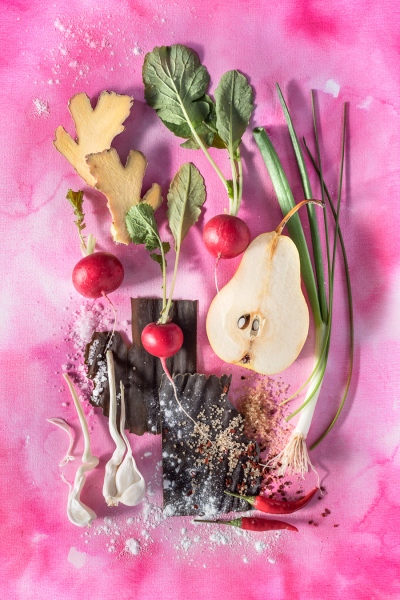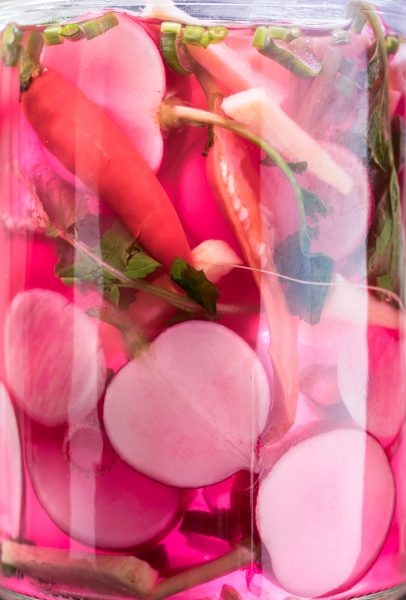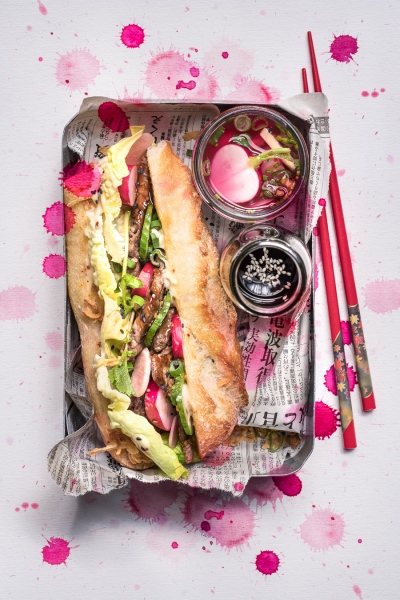Our radish kimchi, one of the water kimchi, does not require as much lead time as traditional kimchi, which often ages for weeks, months or years. After 2-3 days you can already enjoy it and in combination with the beef bulgogi there is a taste explosion on your palate.

Bulgogi sandwich with radish kimchi
Zutaten
RADISH-KIMCHI
- 1.5 l water
- 10 cm Kombu
- 2 tbsp rice flour
- 5 tsp salt
- 1 tbsp sugar
- 1/2 pear cut into cubes
- 1 tsp gochugaru Korean chilli flakes
- 3 garlic cloves finely sliced
- 5 cm ginger finely cut
- 1 red chilli pepper remove seeds and quarter
- 2 bunch radish
- 3 spring onion cut into rings
- 1/2 bunch chives cut into rings
BEEF BULGOGI
- 1 tbsp Japanese rice vinegar
- 1 tbsp rice wine e.g. Japanese sake
- 60 ml light soy sauce
- 20 g fresh ginger finely sliced
- 2 pcs lemongrass finely sliced
- 3 garlic cloves finely sliced
- 1 Nashi pear finely grated
- 50 g brown sugar
- 1 red chilli pepper remove seeds and cut finely
- 1 lime
- 500 g beef hip
BAGUETTE
- 1 1 baguette
- 2 1/2 cucumber sliced
- 3 8 lettuce hearts leaves
- 4 Oyster sauce optional
- 5 Black sesame optional
- 6 Mayonnaise
- 7 Roasted onion
Zubereitung
KIMCHI
- Mix the cold (!) water with salt, flour, sugar. The salt content is correct if it tastes a tick too salty. Add kombu, pear cubes and chilli fur to the mixture and boil with occasional stirring. Remove the algae and allow the mixture to cool well. Puree in a blender.
- Meanwhile, rid radishes of dirt and withered leaves. Do not remove the delicate inner leaves. Wash, depending on size, halve or quarter the heads, drain.
- Give the radish, garlic, ginger, chilli, spring onion, chives in canning glasses. Pour over the chilled salted water. Close well and leave to stand at room temperature for 2 to 3 days. Control the taste in between. Once the liquid tastes not only salty but also sour, keep the radishes kimchi in the fridge. Serve cold at a moment. The radishes kimchi should be eaten within 10 days, otherwise the radishes will become too soft.This recipe / guide of the wonderful radish kimchi comes from the side of missboulette. There you will learn everything about "What makes Kimchi to Kimchi".
BULGOGI
- Place the beef hip in the freezer for 90 minutes.
- Put the ginger, lemongrass, garlic cloves, finely grated pear and the chilli in a shallow bowl and mix together. Add the rice vinegar, rice wine, light soy sauce, brown sugar and the juice of the lime and mix everything together.
- Slice the lightly frozen meat thinly and add to the marinade in the shallow bowl and knead through. Cover and cool for 3 to 4 hours or leave to infuse in the fridge overnight.
- Lightly dry the marinated meat before frying. Preheat the coated pan without oil on high heat and fry the meat in it for about 1 minute from each side briefly. Just place as many pieces of meat in the pan as they fit next to each other and repeat the process more often.
BAGUETTE
- Cut baguette into 4 parts.
- Cut to 2/3 each, brush with mayonnaise inside and sprinkle with roasted onions.
- Spread lettuce leaves, cucumbers, kimchi and bulgogi decoratively into the sandwich halves. Top with black sesame and a dash of oyster sauce as needed.
Which makes kimchi kimchi?
Kimchi is not the name of a single dish, but a method to preserve various vegetables through salt and fermentation. In Korea, the 200 kimi varieties are officially known, unofficially probably as many as there are families. The traditional process of kimchi-making is a combination of the brine-and/or the sauerkraut technique.
Kimchi doesn't always have to be sharp!
Long before chilli was brought to the Korean Peninsula by Portuguese sailors, kimchi already existed, then under the old term Chimi. There are therefore some varieties that are “white” and therefore not spicy. The basis of kimchi-making is the salting of the vegetables and the associated drainage, not the degree of sharpness.
Acid:
Acidity is created automatically over time as a result of the fermentation process by natural lactic acid fermentation, so your kimchi always tastes different depending on the maturity. In the beginning, kimchi tastes mainly spicy, but a fruity-sweet note is clearly visible. Freshly prepared kimchi tastes most to beginners. Then sometime after the first weeks, when the lactic acid bacteria start slowly but have not yet reached the maximum form, there is a short mediocre phase. Neither fresh nor sour, neither fish nor meat. In Korea, it is literally said that the kimchi has gone “crazy.” And nobody likes to eat kimchi that is just going crazy. Here only waiting helps, about 1-2 more weeks. The third and final phase lasts the longest. At this stage, kimchi (depending on the variety, preparation method and storage) can be stored for many weeks, months, sometimes over several years. The color is getting darker and more transparent. Some appreciate the tangy acidity of long-stored kimchi, which tickle somewhere between the palate and nose, similar to carbonic acid.
Water:
It should be better to say this: NO water. Kimchisaft is automatically created after 1-2 days at the latest. This does not require an extra dose of liquid in the form of cold water. Provided you have the vegetables salted properly and not left raw. Pure cold water from a certain amount always means the risk that the kimchi mold. Anything up to 50 ml is possible (but don’t forget to salt extra), everything beyond that is kamikaze.
Sea salt:
Salt is an important ingredient in kimchi and therefore its quality is not insignificant to the result. Good sea salt paradoxically gives the finished kimchi a “sweet” flavour. When using normal salt instead of sea salt, the amount of salt should be reduced. In Korea, sea salt, which has been stored for at least three years, is considered the best salt for kimchi.
Gochujang vs. Gochugaru:
Again and again it is asked whether Gochujang (chilli paste) can also be taken instead of gochugaru (chilli flakes). And the simple answer is: NO. Gochujang, the paste, while delicious, doesn’t make a real kimchi.
Source: https://missboulette.wordpress.com/2014/05/06/was-kimchi-zu-kimchi-macht/



